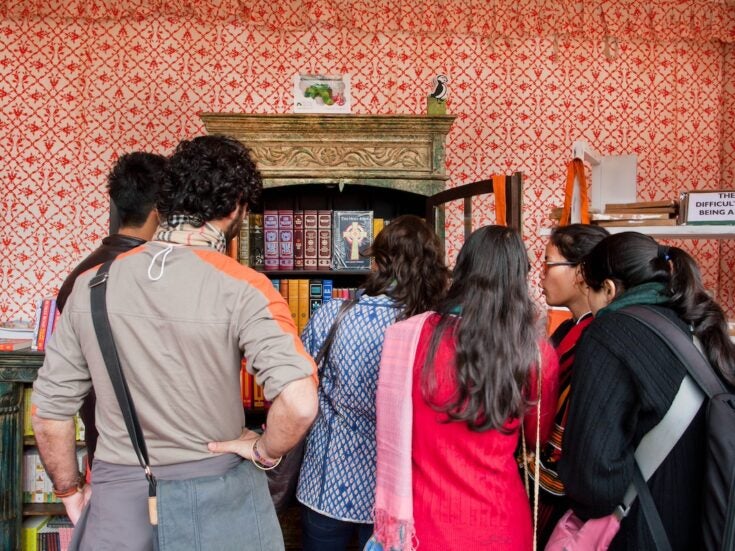
When Spear’s hosted a debate on what makes a masterpiece, none of the participants could agree. Ivan Lindsay was there — but now he has the floor to himself
AT THE MASTERPIECE Fair in London, Spear’s organised a breakfast panel to discuss ‘What is a Masterpiece?’ The discussion, at Le Caprice in the Masterpiece tent in the grounds of Wren’s own masterpiece, the Royal Hospital, was lively because no one could agree on the answer. This is perhaps not surprising, as it is as difficult a question to resolve as ‘What is art?’ Some of the panel were of the opinion that a masterpiece has to be an actual artwork by an important artist and precious, rare, beautiful and moving, whereas others felt it should have a broader application that could be applied to cars, furniture and contemporary design.
Most artists produce poor quality art that never approaches a masterpiece, work that is banal, mediocre and forgotten within a generation. A few good artists produce good art that, having found a formula that sells, they stick to without ever producing anything great. Very few artists produce great work. For painters, these select few can be divided into those who consistently produced masterpieces, who tended to have a small production and limited patronage, such as Manet and Bacon, and Duccio, Mantegna and Giotto from earlier times, and artists who were only sometimes great, such as Picasso, Matisse, Monet and Constable. The latter were always experimenting and, as such, sometimes they succeeded and sometimes not.

Webster’s offers a current definition of ‘masterpiece’ as ‘a supreme intellectual or artistic achievement’, whereas the original meaning of the word was somewhat different, originating in the Middle Ages as a benchmark to judge the work of craftsmen in the guild system. Most trades, including confectionary, goldsmithing, knife-making and painting, allowed a tradesman to submit a work when his peers believed him ready to produce work of sufficient quality for him to sign it and to be judged a master.
Whereas in its original usage masterpiece status was conferred by fellow craftsmen, judgement is now made by art critics, connoisseurs, museum curators and dealers. Whether these people are as well qualified to judge quality as a craftsman’s colleagues is another topic for debate. Some argue that the expression is used so often, and in such a wide context, that it has been debased to include just about anything, usually with the aim of conferring a superior status on an object for the purpose of making a sale. Others maintain that applying it just to major artworks by great artists is a misapplication of the more recent usage of the word and argue that it should include works from all the different fields of manufacture and craftsmanship, more in line with its original meaning.
I lean towards using the word less as opposed to more, and employing it in its more contemporary usage to describe major artworks by the most famous artists whose reputation has increased through the only true measure of an artwork’s merit, the passage of time. A master interprets his own vision, whether an idea or something he saw, in a way that is usually skilled, profound, interesting, perceptive, passionate and harmonious.

A masterpiece is timeless in the way it resonates with generation after generation and appeals to people irrespective of their language, religion or background. It often serves as a window on the past. A master absorbs the spirit of his time and transforms his experience into a universal one. Often people are aware they are in front of a masterpiece and yet they cannot articulate how they know this, as the energy that emits from such a work is metaphysical and therefore indescribable.
PERHAPS THE BEST way to consider a masterpiece is to examine a couple of examples. Rembrandt’s portraits of Jacob Trip (left) and his wife Margaretha de Geer (below left) hang side by side in London’s National Gallery with a wall to themselves in the Rembrandt room. They are painted in Rembrandt’s rough later style that he developed after his bankruptcy of 1656.
The portraits were probably executed after Jacob’s death in 1661 as a memento organised by Margaretha for their children. As such, Rembrandt had to base his likeness of Jacob on other earlier portraits by fellow artists such as Nicolaes Maes, while Margaretha was painted from life. Jacob Trip sits in a chair wearing a cap, white scarf and coloured shift while holding a stick. One of the richest men in Europe, having made a fortune in mining, iron manufacture, arms manufacture and arms dealing, he gazes coldly back at the viewer with the steely expression of a man used to getting his own way.

The smaller, vibrant study Rembrandt made of Margaretha is also a masterpiece, although, amazingly, the attribution to Rembrandt was doubted for many years by the so-called Rembrandt Research Project (RRP). The RRP was set up by the Dutch government to clear up once and for all the disputed attributions to Rembrandt. An amazingly incompetent and arrogant committee, it took no one else’s views into consideration and just went through Rembrandt’s oeuvre making frequently flawed attributions to Rembrandt or otherwise.
Margaretha is depicted head on, looking at the viewer. She is wearing a white ruff, a black cape and an odd hat and is holding a white handkerchief. Her hands are strangely masculine and heavy. Rembrandt was perfectly capable of painting a good hand if he wanted to, but in his portraits he often reduces everything except the face to peripheral detail to focus the viewer’s attention on the face. Her skin is parchment soft and her watery eyes gaze unseeing back at the viewer. Her clothes are 30 years out of fashion — she must have kept them from the time when she had been interested in such matters and pulled them out especially for the portrait.
Life as the wife of Jacob Trip must also have been an interesting journey, and she resonates with an energy that is both resigned towards the end drawing near and yet facing it with a calmness and peace that many people know from their own grandparents in their final years. These two paintings remain fascinating and moving on many different levels.
Just around the corner in the National Gallery hangs Rubens’s portrait of Susanna Fourment (below), painted some 40 years earlier, in around 1622, on the occasion of her second marriage. This painting is known as Le Chapeau de Paille (The Straw Hat), which is curious as she is wearing a felt hat with feathers on it of a design that was popular for both men and women in Flanders in the 1620s.

Susanna stands wearing a formal evening dress with cape and precious diamond-drop earrings, which were probably a gift from her father, the rich silk merchant David Fourment. The painting demonstrates the accomplishment and bravado that Rubens was capable of infusing into paintings of close family members. There is a hint of sadness in her expression, perhaps over the recent demise of her first husband. Susanna’s younger, prettier sister would later marry Rubens, who was good-looking, a linguist, a diplomat who negotiated peace treaties for his king, a lover of life, a successful artist with a studio that at times housed over 50 assistants, and he lived in a palace on one of Antwerp’s finest streets.
These three great paintings have been considered masterpieces since the day they were painted. Today they remain much loved and enjoyed by thousands of people every day. While many argue that if you believe something is a masterpiece then it is one, this argument sounds as ridiculous as saying you are a brain surgeon because you believe you are one. (Scalpel anyone?) Perhaps the time has come to stop debasing this expression by making it all-inclusive and to raise the bar once again and use it only for artworks of major importance by leading artists who belong to the rarefied canon that includes the best artworks ever created.
Rubens: Portrait of Susanna Lunden; Rembrandt: Portrait of Jacob Trip; Rembrandt: Portrait of Margaretha de Geer, Wife of Jacob Trip © The National Gallery, London







